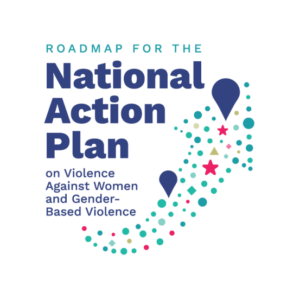 9 November 2023 – The National Action Plan (NAP) to End Gender-based Violence (GBV) was launched on November 9, 2022 by Women and Gender Equality Canada. On the one-year anniversary, the following represents what gender justice organizations know to date, concerns that remain, and recommendations to move forward collectively with government.
9 November 2023 – The National Action Plan (NAP) to End Gender-based Violence (GBV) was launched on November 9, 2022 by Women and Gender Equality Canada. On the one-year anniversary, the following represents what gender justice organizations know to date, concerns that remain, and recommendations to move forward collectively with government.
What we know:
The bilateral NAP agreements have been negotiated with the provinces and territories over the last year. At the end of July 2023, announcements about the signing of these agreements began. This funding is designated to the five Pillars included in the NAP (1) support for victims, survivors, and their families; 2) prevention; 3) responsive justice systems; 4) implementing Indigenous-led approaches; and 5) social infrastructure and enabling environment), although spending in all Pillars is not required in each year of the agreement. The agreements require 25% of funding to be invested in the Prevention Pillar. How funds are spent is at the discretion of the province or territory, although funding needs to be designated toward investments that had not already been announced and must fit into the five Pillars. Provinces and territories will be required to engage in annual reporting for continued receipt of funds.
As of now, agreements that cover the period 2023/24 to 2026/27 have been announced in the following provinces and territories:
- Alberta – $54.1 million
- Manitoba – $22.3 million
- Northwest Territories – $16.4 million
- Nunavut- $16.4 million
- Prince Edward Island – $9.6 million
- Saskatchewan – $20.3 million
- Yukon – $16.4 million
The content of the signed agreements has not been shared publicly; however, Women and Gender Equality Canada has committed to making the bilateral agreements public once all are signed.
Concerns:
We applaud the government’s commitment to addressing gender-based violence, yet remain concerned, as there are several areas which remain unclear.
The gender justice sector has repeatedly asked for greater accountability and transparency including a recommendation in the NAP Roadmap document for an oversight role for GBV/VAW experts. To date, within provinces and territories, expert organizations have, by and large, been left out of negotiations, including priority setting within bilateral agreements. We also have no clarity on how the NAP will be monitored and evaluated.
For over a decade, the sector has been calling for consistency across and within jurisdictions in policies and legislation that address GBV along with consistent approaches to prevention of and responses to GBV. Although much needed funding is being distributed across the country, there appears to be a lack of coordinated activities and cohesion. While the Federal GBV Strategy could serve to bridge this gap, it remains unclear if and how the NAP and the Federal GBV Strategy connect to one another.
Recommendation:
Many of our concerns stem from a lack of transparency. To address this, we recommend that the federal government immediately proceed with the implementation of the Nova Scotia’s Mass Casualty Commission’s recommendation 17: National Accountability Framework.
“The Commission recommends that: (a) The federal government establish by statute an independent and impartial gender-based violence commissioner with adequate, stable funding, and effective powers, including the responsibility to make an annual report to Parliament. (b) The federal government develop the mandate for the gender-based violence commissioner in consultation with provincial and territorial governments, women survivors including women from marginalized and precarious communities, and the gender-based violence advocacy and support sector.
The commissioner’s mandate could include:
- Working with governments and community organizations to promote coordinated, transparent, and consistent monitoring and evaluation frameworks.
- Providing a national approach to victim-survivor engagement, to ensure their diverse experiences inform policies and solutions (similar to the Australian Domestic, Family and Sexual Violence Commission).
- Developing indicators for all four levels of activity (individual, relational, community, societal) and reporting to the public at least once a year.
- Establishing and working with an advisory committee that consists of women survivors, particularly marginalized women survivors, and representatives of the gender-based violence advocacy and support sector.
- Contributing to a national discussion on gender-based violence, including by holding biannual virtual women’s safety symposiums.
- Assisting to coordinate a national research agenda and promoting knowledge sharing.”
 Signed,
Signed,
Collaborators on the Roadmap report:
Action ontarienne contre la violence faite aux femmes
Alliance des maisons d’hébergement de 2e étape
Awo Taan Healing Lodge Society
Barbara Schlifer Commemorative Clinic
Battered Women’s Support Services
Canadian Association of Elizabeth Fry Societies
Canadian Centre for Policy Alternatives
Canadian Labour Congress
Canadian Women’s Foundation
Colour of Poverty – Colour of Change
Ending Violence Association of Canada
Institute for Research and Development on Inclusion and Society
Luke’s Place
Provincial Association of Transition Houses and Services of Saskatchewan
Québec contre les violences sexuelles
Rise Women’s Legal Centre
South Asian Legal Clinic of Ontario
West Coast LEAF Association
Yukon Status of Women Council

